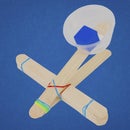Introduction: The Best Rubber Band Car
Rubber bands are a convenient and effective way to teach energy transformation, and this rubber band car makes that lesson a blast!
A quick Google search for "rubber band car project" yields tens of thousands of results, so why reinvent the rubber band-powered wheel? The top results show cars with small wheels without traction, or CD wheels which are difficult to attach to an axel, both of which aren't ideal for project-based learning.
One of the keys to a successful rubber band car are large wheels with rubbery grip that don't slip on the axel. With this, you can design the car to speedily sprint a short distance, or travel a long distance. Read on after the final project step to learn how to alter the design of the car to achieve each type of goal, and to see the accompanying teaching materials.
This project is recommended for grades 4 and up, however smaller groups of younger students may build this car with extra help.
You can find the lesson plan, 1-page project sheet, and more project ideas at STEM-Inventions.com
Step 1: Tools and Materials
The Engineering Creation Kit has everything you need for this project and many more from STEM Inventions.
Tools
Materials
- (14) Craft sticks
- (6) Craft cubes (Bulk pack)
- Large plastic wheel set (wheels, dowels, rubber bands)
- (1) Plastic straw
- Masking tape
- (1) 4" cable tie
- (1) 1/8x7" #117b rubber band
- Optional: Small plastic wheels and 1/8" dowels
- Optional: Heavy materials, like metal washers
When you make a purchase through these links, I may earn an affiliate commission at zero cost to you.
Step 2: Build the Frame
Create a frame that's 2 craft sticks long as shown (picture 1).
Glue on craft cubes as shown, then replicate the same frame pattern on top (picture 2). This cube-and-stick structure prevents the frame from bending.
Important: Notice how the cubes on the right side of picture 2 are not glued to the very end of the craft sticks. There needs to be a gap between the cube and the end of the sticks that's about 1/2". This is a key part of the frame that will be necessary for the next step.
It's also important to avoid gluing across that gap. Click on Picture 1 for a clarifying annotation.
Step 3: Make the Drive Wheels
The next step is to attach the rubber bands to the wheels, which will add traction. Without the rubber bands, the wheels will spin out and waste energy before the car overcomes its inertia and begins moving.
Adding the rubber bands can be tricky. The best method is to hold a rubber band against the edge of the wheel with your thumb, then carefully work it onto the wheel with your other hand (picture 1). Repeat with all 4 wheels. You may need to prep this step for students in grades 5 and under.
Fit a wheel onto a dowel, then cut two pieces of straw that are about 0.5" long. Put the straw pieces onto the dowel, then fit another wheel on (picture 2).
Important: The wheels must fit snugly. If the dowels fit loosely, then wrap a layer of masking tape around the end of the dowel before inserting it into the wheel (picture 3).
Step 4: Attach the Drive Wheels
Use a liberal amount of hot glue to attach the straw pieces to the frame. Make sure to glue the straws to the gap that was created when making the frame (picture 1 & 2). This placement ensures that the drive wheels are pulled against the edge of the frame when the car is wound up. If the drive wheels are glued or taped anywhere else on the frame, the force of the wound-up rubber band will rip it off.
Step 5: Create the Idle Wheels
Create a set of wheels just like the last step, except this time use a 4.5" (11cm) piece of straw. These wheels can be taped to the other side of the frame since there'll be no rubber band pulling on it (picture 1).
The purpose of these wheels is to reduce friction (versus the frame dragging on the ground) and add some weight to increase momentum. These wheels can also improve how straight the car rolls. Having 4 wheels with rubber bands in contact with the ground helps prevent the car from veering to the side.
Important: The four wheels must be aligned. In other words, the dowels must be parallel to each other. Otherwise the car will veer to the side.
Step 6: Attach the Rubber Band
Tie a rubber band around the frame using a hitch knot near the idle wheels (picture 1). Make sure to avoid tying it around the straw or else it will pinch the idle wheel dowel and prevent the wheels from turning.
Tie a cable tie to the drive wheel dowel. Pull it as tight as possible, then cut off the excess (picture 2). This is where the rubber band will be attached to the drive wheels. If the cable tie slips in the next step, then apply a small amount of hot glue to it.
Step 7: Wind It Up!
Hitch the rubber band onto the drive wheel dowel (picture 1).
Wind up the rubber band around the dowel (picture 2). I recommend using your index finger to quickly spin the drive wheels in circles until the rubber band is wound around the drive axel many times (picture 3).
Step 8: Go for Speed or Distance?
The basic car design works well and it can still teach students about momentum, energy transformation, and inertia. However, if you want to specialize the car for either speed or distance, then read on:
Designing for Speed
- The car takes time to reach maximum speed because of inertia. Inertia is the tendency for an object to resist change in motion. In other words, it’s how much energy is required to move an object.
- Heavier, more massive objects have more inertia and require more energy to start moving. In this case, any excess weight requires extra energy to move before the car can reach top speed.
- Therefore, to make a speedy car, it must be as light as possible.
- To that end, you can change out the idle wheels with small wheels (picture 1), or experiment with reducing some of the materials used in the frame. The drive wheels must remain large; small wheels have too little inertia, and will spin in place when the car is released instead of gripping the floor and propelling the car forward.
- Furthermore, you can experiment with using more than 1 rubber band. More rubber bands will increase the overall amount of energy that can be stored and converted to kinetic movement, and it will increase the amount of energy released in the same period of time as just 1 rubber band. In other words, 2+ rubber bands can accelerate the car faster, however if there are too many, the torque (rotating force) will be so great that it will cause the wheels to spin in place before they can gain traction, or you may even destroy the frame.
Designing for Distance
- The reason the car doesn't go on forever is because of friction. Friction is when two objects rub against each other and slow down, usually by converting kinetic energy to heat.
- The car generates friction mainly in the form of the spinning dowel rubbing the inside of the straws.
- Assuming there's no excessive friction, like a bit of hot glue stuck inside the straw, then to get the car to go farther it needs to use the stored energy more effectively. Adding more mass will do this.
- Why? Adding more mass will generate more momentum, which is the tendency for an object to keep going in its current trajectory. For example, adding washers to the drive wheels increases its overall mass, and its potential to generate momentum (picture 2).
- The additional momentum is harder to slow down and stop, so the small amount of unavoidable friction does not slow down the car as much as before. Therefore, the extra momentum "carries" the car a farther distance.
- However, if it's heavier, it'll take longer to accelerate, and because momentum = speed x mass, the car must reach a high speed to generate that extra momentum.
- To achieve greater velocity, you can use more than 1 rubber band (picture 2). Because the drive wheels are heavier, it will generate more traction and will be less likely to slip due to the extra torque.
- Importantly, the additional mass must be added to the wheels. If it's added to the frame, then the friction between the dowels and the inside of the straws will increase. This is because the weight of the frame is resting on the dowels, so by adding mass to the frame, it will weigh heavier on the dowels and increase the friction. This will actually cause the car to perform worse than without any extra weight.
In either case, if you're facilitating this project with students, encourage experimentation and observational learning. Even if their initial ideas don't work as well as the basic example, those failures will create opportunities to learn about the physics principles at hand.
Step 9: Lesson Plan & Project Sheet
If you're planning on teaching this project to a group of kids, then download the attached lesson plan and project sheet. Like all of my lesson plans, it contains the project goal, prep, troubleshooting, and a suggested lesson plan. The lesson plan is an outline, and it's provided as an editable .docx file, designed to be elaborated upon to suite your audience.
To download the Project Sheet, click on the image and then click on the download button in the lower left corner. Or, right click and open the image in a new tab, then right click and save the image.
The project sheet can be used as a teaching aide for students in grades 5 and up. For grades 4 and under, I recommend showing how to build the car step-by-step, and then use the project sheet as a reminder of the steps. Print out one project sheet for every 2 students.
Thanks for reading this far! If you'd like more science and engineering projects like this, then check out Made for STEAM.
Attachments

Runner Up in the
Classroom Science Contest














